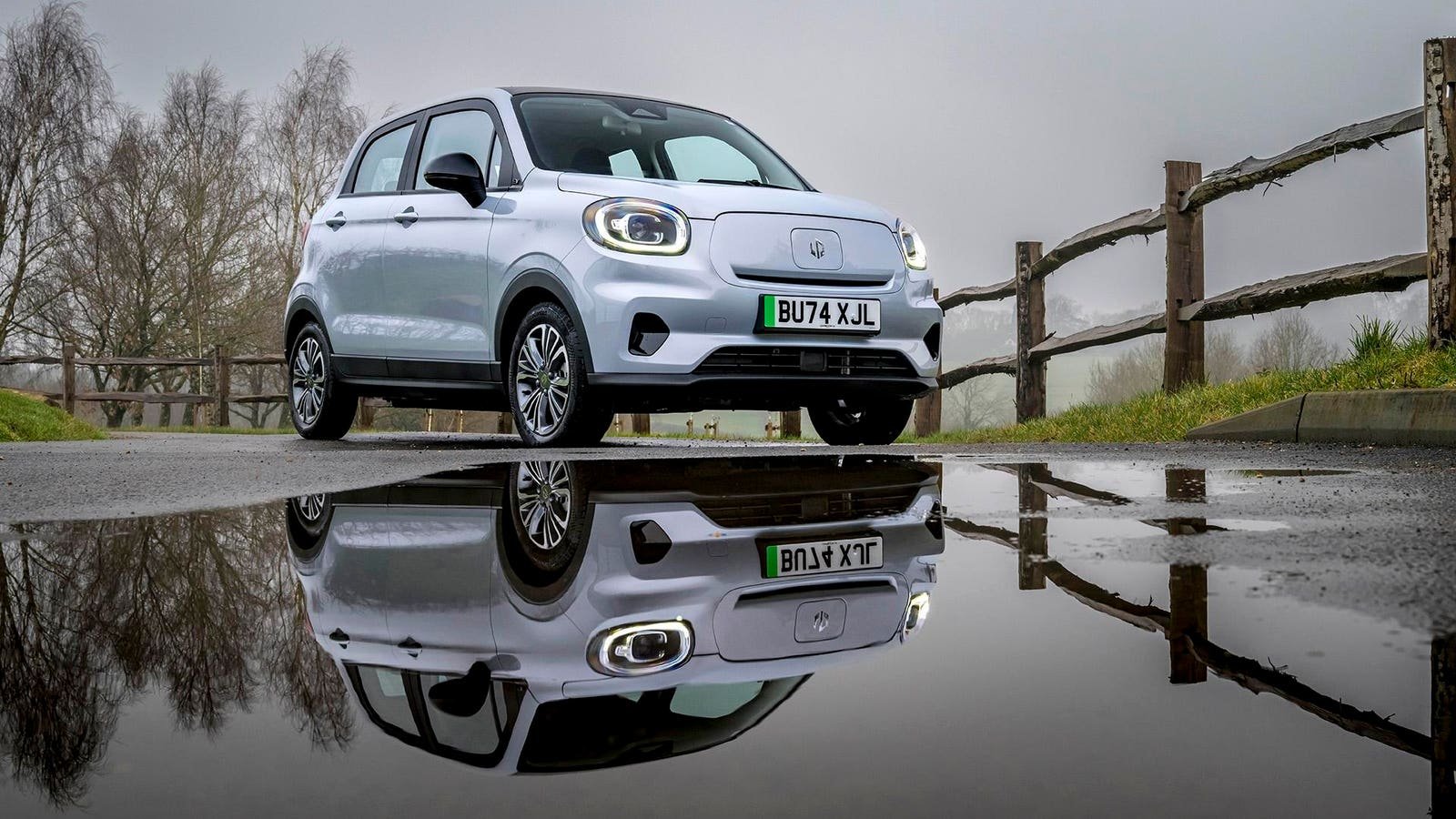The Leapmotor T03 is both keenly priced and highly specified.
Electric cars are still too expensive. But the gap is narrowing, and vehicles made in China have been leading the charge. One of those Chinese brands is Leapmotor, which arrived in the EU in October 2024. Now it has launched in the UK as well, promising to set a new level for affordability and quality. I took Leapmotor’s first two models for a test drive.
Leapmotor: Not Quite Another Chinese Brand
Leapmotor isn’t quite the same as other Chinese EV automakers such as XPENG and BYD, because 51% of the International wing is owned by Stellantis (the European conglomerate only owns 21% of the local Chinese company). While one of the cars just launched in the UK will be shipped from China (the C10), the cheapest one, the T03 is made in Tychy, Poland. So, in theory, it should avoid tariffs in Europe no matter where taxation heads in these turbulent economic times.
Leapmotor will sit alongside Stellantis’s other eight marques in its showrooms (totalling 60 by the end of the first half of 2025), and benefit from the company’s extensive network of maintenance centers. Stellantis claims it should have 95% parts availability in Europe, where other Chinese automakers have problems fixing their cars quickly when they go wrong. The truth of these assertions will remain to be seen until cars arrive on British roads in March. But being immune from the impending tariff wars certainly gives Leapmotor some built-in stability.
Leapmotor is a Chinese brand, but it enters Europe with the backing of Stellantis.
The two cars launched in the UK so far sit at different ends of the market. One is an ultra-cheap A-segment supermini hatchback imaginatively called the T03. The other is a D-segment SUV (which Leapmotor argues is priced at the same level as a smaller C-segment vehicle) called the C10. Both have premium features and the possibility of challenging their respective sections of the EV market, but the T03 is the most significant. There are few electric cars available for under £20,000 ($25,000), and most are only short-range city runabouts. Now there is starting to be competition in this price bracket.
Leapmotor T03 Test Driven
The T03 isn’t the cheapest EV on sale in the UK. That’s still the Dacia Spring, which starts at £14,995 ($19,000). However, of the three versions of the Spring you can buy, the T03 sits in the middle pricewise, with a specification that is higher than any of them. The Dacia Spring Electric 65 combines a 65hp motor and 26.8kWh battery, giving it 140 miles of WLTP range. Only the Extreme version has an infotainment screen, and that costs £16,995 ($21,500).
In contrast, the one spec available for the Leapmotor T03 boasts a 46% more powerful 95hp motor and 39% larger 37.3kWh battery. This means it offers a WLTP range of 165 miles. The T03 also comes with alloy wheels, a 10.1in infotainment screen, sunroof, and automatic air conditioning. The base price is £15,995 ($20,000), placing it directly against the Dacia Spring Expression Electric 65, which lacks all these niceties. The non-white paint choices for both cars are £650 ($800), although the Spring has more options here (five color upgrades versus just blue and silver for the T03).
The Leapmotor T03 competes directly with the Dacia Spring on price, but promises more premium … [+]
I can’t fault the Dacia Spring for value and usability. I drove one in Germany last year and found it an impressively practical vehicle for the money. But it’s clearly a budget car, with door cards that flex when you press them. The Leapmotor T03, while not exactly top-end premium, does feel a cut above this in terms of build quality. The looks are a matter of taste for both, but the T03 has a little of the Fiat 500 about it too.
The T03 is not a large car. There’s plenty of space in the front for even reasonably tall adults, but the back is more cramped. A tall adult will feel a bit claustrophobic sitting behind another tall adult in the front, although the sunroof will ease that a little. The Dacia Spring is no better in this respect. One area where the T03 does fall behind the Spring, however, is in rear cargo capacity, with 210 liters compared to the Spring’s 308 liters. This figure is also low in its class. The capacity only extends to 508 liters with the rear seats down, but the Spring offers 1,004 liters.
The Spring drives perfectly well for a city car, but the T03 is cut above that with its extra power. It reaches 62mph in 12.7 seconds, which is decidedly pedestrian for an EV. However, the Dacia car is slower still, taking 13.7 seconds even with the 65hp version. The T03 feels fine on A-roads and highways, particularly if you put it in Sport mode.
During my test driving, in very cold weather, I managed 3.8 miles per kWh, which would equate to a real-world range of 141 miles. That’s not going to be great for long-distance journeys, although they will just about be possible. DC charging is only at 48kW, so it takes 36 minutes to go from 30% to 80%, while home charging on a 7kW unit takes a little over six hours from zero to full. If you did try driving a long way, you’d probably have to stop every hour and a half for at least 30 minutes to top up.
Despite its low price, the T03 feels quite high quality inside.
While the T03 doesn’t have a Euro NCAP rating yet, there’s a good chance this will be good when it does arrive because the level of safety tech is decent. The ten ADAS functions include blind spot detection, lane departure warning and even adaptive cruise control. There’s also a decent rear parking camera.
It’s great that there is an infotainment screen included, and at 10in it’s not tiny. However, it sits low on the dashboard, so your hand on the steering wheel obscures some of it. There is a decent connected satnav, but Apple CarPlay and Android Auto aren’t supported. The air condition controls are also exclusively touchscreen-operated, and the interface is fiddly, making it tricky to change settings while driving.
That brings us back to the price. You will be able to lease the T03 for £199 a month with just a £199 down payment, making this an incredibly accessible EV for almost any income level. The Dacia Spring already put electric hatchbacks in among cheap internal combustion-powered alternatives like the Kia Picanto, Hyundai i10 and Toyota Aygo. But the Leapmotor T03 sits in the same space, with more features, better performance and better range. Despite the few niggles, it takes EVs to a new mainstream level of affordability.
Leapmotor C10 Test Driven
The other car Leapmotor has launched in the UK so far, the C10, is less revolutionary. Pricewise, it sits alongside an increasingly crowded market for mid-sized SUVs and crossovers. However, Leapmotor has again provided a high level of equipment for the money, with just one trim level costing £36,500 ($46,000) and £700 ($900) extra for paint upgrades. This is a little more expensive than Chinese competitor the Omoda E5, but undercuts the Kia Niro Electric, BYD ATTO 3 and Volkswagen Group alternatives.
There’s plenty of passenger space front and back, assisted by a panoramic sunroof as standard. Rear cargo space is not class leading, merely acceptable, with 435 liters and 1,410 liters with the rear seats down. There are some hatchbacks that get close to these figures, such as the Volkswagen ID.3.
The drivetrain specification is about what you would expect at this price. The motor offers 218hp, and the battery has a 69.9kWh capacity, giving a WLTP range of 263 miles. The C10 sprints to 62mph in 7.5 seconds, which is also on par with a car in this class. In sport mode, it has plenty of grunt for overtaking and the ride quality is decent. I managed 3.4 miles per kWh during my test driving, equating to 237 miles of real-world range. However, DC charging only reaches 84kW. Leapmotor quotes 30 minutes for 30% to 80%, but the more usual 10% to 80% could take closer to 45 minutes, which will start to grate on longer journeys.
The Leapmotor C10 is enters a much more competitive portion of the EV market.
There are plenty of premium touches like hidden door handles, 20in alloy wheels and a heat pump as standard. Alongside that panoramic sunroof, you get heated and ventilated front seats, which are also electrically adjusted. There’s privacy glass and a tailgate that can be opened with a kick gesture. The 14.6in touchscreen has a more well-rounded interface than the T03 and is pleasantly responsive, but again there is no support for Apple CarPlay or Android Auto, which will be a disappointment for many.
Unlike the T03, the C10 has had its Euro NCAP rating, and it got a reassuring five stars. The adaptive cruise control includes traffic jam assist, and there’s rear cross traffic alert (handy if you’re backing out of somewhere with poor visibility). During my test drive, some of the safety options were too intrusive and needed disabling – an increasingly common problem – but once that was done the experience was smooth.
The Leapmotor C10 doesn’t make quite such a bold statement as the T03. It’s still a promising option, but there are plenty of competitors and MG is just about to launch an update to its extremely popular and keenly priced ZS EV. So it faces some strong alternatives, despite offering a comprehensive and premium-grade specification for the money.
Can Leapmotor Jump Over The Competition?
Leapmotor has made a bold entry into the UK market. The T03 takes ultra-affordable EVs up a bar in quality, and the C10 looks like good value too. A third car, the B10, is set to arrive in the UK by the end of 2025. It was already on show at the UK launch. Then Leapmotor plans to release two more vehicles in 2026, and another in 2027, bringing the range to six.
The B10 will be Leapmotor’s next EV to hit the UK, by the end of 2025.
Whatever happens with the Zero Emission Mandate, secondhand prices for EVs, and import tariffs, the shift to electric vehicles is carrying on regardless. The Leapmotor T03 in particular reduces any price differentiation between EVs and internal combustion equivalents, while the C10 further piles on the competition in the popular mid-range SUV market. These are good signs that the adoption of electric vehicles will continue its growth of the last few years into 2025 and beyond.




